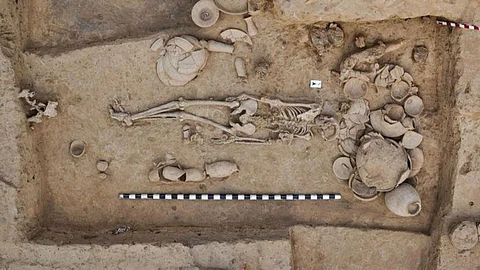
- HOMEGROWN WORLD
- #HGCREATORS
- #HGEXPLORE
- #HGVOICES
- #HGSHOP
- CAREERS
- ABOUT US
- CONTACT US

In the beginning of time — or, more like 3300 BCE — in a land now known for its rich culture and history, there was once a thriving Bronze Age metropolis called Rakhigarhi.
The Early Harappans rolled in on their one-horned fantastic beasts, looked at the Ghaggar-Hakra river plains, and said, “a’ight lads, this looks like the perfect spot to build a civilisation that future social media historians will vigorously gesture towards to prove the ‘out of India’ theory, innit?”
The founders of Rakhigarhi constructed homes, granaries, and streets so geometrically efficient they’d make Le Corbusier cry with euphoria. Their biggest flex? Standardized terracotta bricks. Take that, uneven cobblestones of medieval Europe!
But then a lot of things happened, and everyone forgot about Rakhigarhi. Fast-forward 5,000 years, and Rakhigarhi, now in Haryana, sat quietly in the corner like an awkward prepubescent teen with braces and an unibrow while its better-looking cousins Harappa and Mohenjo-Daro hogged all the attention from nerdy, hot Indiana Jones-types, also known as archeologists. “Oh, look at us, we’re UNESCO World Heritage Sites!” they’d tweet.
Meanwhile, Rakhigarhi’s modern residents farmed wheat over most of the ancient city, blissfully unaware that they were tilling the backyard of history’s most underrated urban planner. Then, in the ’90s — ah, the good ole’ ’90s — the archaeologists finally decided to pay attention to Rakhigarhi. “You’ve been sitting on the largest Indus Valley Civilisation site ever!” they gasped, clutching their tiny trowels.
These chaps then Rakhigarhi out, one clay brick at a time. Paved streets! Drainage system! Public wells! A large rainwater reservoir! They compared all that to New Delhi, where the public wells these days are the WhatsApp family groups where your problematic uncle shares conspiracy theories, and wept into their field notes. "They had it all figured out... and then they disappeared," they cried out in anguish.
In any case, in 2018, Rakhigarhi — now in her prime baddie years — did the baddiest thing a baddie can do: she went viral. Archaeologists found the 4,600-year-old remains of a woman in Rakhigarhi, and DNA analysis of the skeleton opened a Pandora’s box of genomics, history, archaeology, and linguistics. The tea? Her DNA showed a mix of Ancient Iranian and South Asian Hunter-Gatherer ancestry only. She had no Steppe ancestry. Cue drama! Gasp! Gasp! Gasp! The Social Media historians hyperventilated. Fans of the Aryan Migration Theory shook their heads. The we’ve-always-been-here club high-fived over samosas with green chutney. Meanwhile, the ghost of the Rakhigarhi woman rolled her eyes over the antics of her great-to-the-nth-power grandkids.
Oh and did I mention that Rakhigarhi’s may have been situated by the mythical river Sarasvati? You know that underworld river your mum said we have at home when you wanted to go see the Styx with your Greek friend Papadopoulos? Yeah, some insist it was that Sarasvati, while others say it was just the Ghaggar-Hakra seasonal stream, leaving archeologists to argue over Google Earth screenshots like it’s an episode of CSI: Protohistory.
If you enjoyed reading this, here's more from Homegrown:
Punya Chatterjee's 'Chakras For Sale' Satirizes The Absurd Reality Of Appropriation
How 10th-Century Performance Art From Kerala Paved The Way For Modern Homegrown Satire
